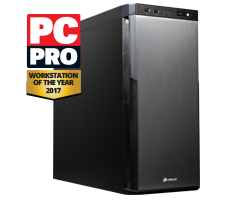SCANZONE
10.11.17 | ISSUE 54
The last few weeks have been packed with exciting technology launches so we held back the latest issue of Scanzone to be to cover them all in one bumper edition. The two main highlights are Intel’s first desktop CPUs based on the new 8th gen Coffee Lake architecture, which provides up to 100% more cores plus NVIDIA’s new GTX 1070 Ti graphics card. Read on to find out more about these hot new products and many others.

1. Intel 8th gen Core Coffee Lake CPU review
Intel’s 7th generation Core ‘Kaby Lake’ processors are less than a year old, being introduced in January this year, but their replacement is already here. The launch of the new 8th generation Core ‘Coffee Lake’ has been brought forward significantly due to increased competition in the CPU market, with AMD offering some very compelling Ryzen processors.
Thanks to the schedule change Coffee Lake processors will get a staggered release, with six CPUs being released now along with one chipset, the Intel Z370, with more CPUs and chipsets to follow early next year.
Unusually for a new generation of CPU there aren’t a whole lot of architectural differences between Kaby Lake and Coffee Lake. Instead, Intel has focussed its R&D efforts on squeezing in more cores, with a significant jump of between 50% and 100% more cores depending on the model.
Like the current 7th gen Core Kaby Lake processors the new 8th gen Core Coffee Lake processors use the Socket 1151 packaging and so from the outside they look more or less identical. However, as the new chips consume more power than their predecessors, Intel has changed the pinout of the socket. This means you can’t just slot an 8th gen CPU into a 7th gen motherboard, it simply won’t boot and your precious new hardware may be damaged.
This means that to use an 8th gen CPU you’ll need a new motherboard based on the Intel Z370 chipset. Unfortunately this doesn’t add any features over the existing Z270 chipset, so there’s still no native support for USB 3.1 or any more PCI-E lanes. Either way, if you want to upgrade to an 8th gen CPU now you have no choice but to buy a Z370 motherboard.
The initial line up of 8th gen processors includes six models, two Core i7s, two Core i5s and two Core i3s, with one K-sku which has an unlocked multiplier for easy overclocking per family. The new Core i7s and Core i5s have 50% more cores than the previous 7th gen Kaby Lake CPUs, so now have 6-cores, the first time Intel has provided this many cores in a mainstream Z-platform CPU. Meanwhile the new Core i3s have 100% more cores than the earlier 7th gen Core i3s CPUs, growing from dual-core CPUs into quad-core CPUs. However, all six new CPUs do run at a slightly lower frequency than the 7th gen equivalents, which does impact performance in lightly threaded software.
This table highlights the key differences between the 8th gen Coffee Lake Core i7 CPUs and 7th gen Kaby Lake CPUs.
| Generation | 8th | 8th | 7th | 7th |
|---|---|---|---|---|
| CPU | Intel Core i7 8700K | Intel Core i7 8700 | Intel Core i7 7700K | Intel Core i7 7700 |
| Architecture | Coffee Lake | Coffee Lake | Kaby Lake | Kaby Lake |
| Cores | 6 + 6 HyperThreading | 6 + 6 HyperThreading | 4 + 4 HyperThreading | 4 + 4 HyperThreading |
| Base Frequency | 3.7GHz | 3.2GHz | 4.2GHz | 3.6GHz |
| Turbo Frequency | 4.7GHz | 4.6GHz | 4.5GHz | 4.2GHz |
| Cache | 12MB | 12MB | 8MB | 8MB |
| Memory Controller | Dual-channel DDR4 | Dual-channel DDR4 | Dual-channel DDR4 | Dual-channel DDR4 |
| PCI-E 3.0 lanes | 16 | 16 | 16 | 16 |
| TDP | 95W | 95W | 91W | 91W |
This table highlights the key differences between the 8th gen Coffee Lake Core i5 CPUs and 7th gen Kaby Lake CPUs.
| Generation | 8th | 8th | 7th | 7th |
|---|---|---|---|---|
| CPU | Intel Core i5 8600K | Intel Core i5 8400 | Intel Core i5 7600K | Intel Core i5 7400 |
| Architecture | Coffee Lake | Coffee Lake | Kaby Lake | Kaby Lake |
| Cores | 6 | 6 | 4 | 4 |
| Base Frequency | 3.6GHz | 2.8GHz | 3.8GHz | 3.0GHz |
| Turbo Frequency | 4.3GHz | 4.0GHz | 4.2GHz | 3.5GHz |
| Cache | 9MB | 9MB | 6MB | 6MB |
| Memory Controller | Dual-channel DDR4 | Dual-channel DDR4 | Dual-channel DDR4 | Dual-channel DDR4 |
| PCI-E 3.0 lanes | 16 | 16 | 16 | 16 |
| TDP | 95W | 65W | 91W | 65W |
This table highlights the key differences between the 8th gen Coffee Lake Core i3 CPUs and 7th gen Kaby Lake CPUs.
| Generation | 8th | 8th | 7th | 7th |
|---|---|---|---|---|
| CPU | Intel Core i3 8350K | Intel Core i3 8100 | Intel Core i3 7350K | Intel Core i3 7100 |
| Architecture | Coffee Lake | Coffee Lake | Kaby Lake | Kaby Lake |
| Cores | 4 | 4 | 2 + 2 HyperThreading | 2 + 2 HyperThreading |
| Base Frequency | 4.0GHz | 3.6GHz | 4.2GHz | 3.9GHz |
| Cache | 8MB | 6MB | 4MB | 3MB |
| Memory Controller | Dual-channel DDR4 | Dual-channel DDR4 | Dual-channel DDR4 | Dual-channel DDR4 |
| PCI-E 3.0 lanes | 16 | 16 | 16 | 16 |
| TDP | 91W | 65W | 60W | 51W |
We put all three new k-SKU 8th gen Coffee Lake CPUs through their paces, comparing their performance with their direct predecessors from the 7th gen Kaby Lake series plus AMD’s closest price Ryzen 5 and Ryzen 5 CPUs. All nine processors were tested using the same overall configuration comprising 16GB of Corsair Vengeance DDR4, EVGA GeForce GTX 1080 graphics and a Corsair H100i hydrocooler to ensure a fair comparison.

The first benchmark we tried was the photo editing application GIMP. As GIMP is only single-threaded the results were very interesting indeed, with two of the fastest results coming from Intel 7th gen CPUs due to their high IPC (instructions per clock) and frequency. Meanwhile the Intel 8th gen parts took middle place with AMD’s Ryzen processors taking last place.

The next benchmark we ran was encoding an H.264 video in Handbrake. As the program is multithreaded the CPUs with high core counts turned in the fastest results, with the Ryzen 7 1700X taking pole position as it has eight physical cores and eight SMT cores, the highest in this price bracket. That said, thanks to their extra cores the Intel 8th gen did show a marked improvement in performance over the Intel 7th gen CPUs, with up to a 51% speed boost evident.

We also ran the 3D rendering benchmark Cinebench on all the CPUs, which again like with Handbrake was won by the Ryzen 7 1700X, albeit with a massive improvement in performance by the 8th gen Intel CPUs.

Finally, we also tested the CPUs using the gaming benchmark 3DMark FireStrike and as expected the Intel CPUs took the top positions on the graph in this test thanks to their high IPC and frequency.
Conclusion
2017 has been the most interesting year in CPUs for nearly a decade, with increased competition between Intel and AMD leading to increased innovation, shorter product cycles and lower prices.
The 8th gen Intel Core launch is the latest example of this trend, with six new processors being launched that offer much greater performance than their predecessors.
At the top of the range the new 6-core Core i7s, especially the 8700K, are a real treat, offering fantastic performance in both lightly threaded games and heavily multithreaded content creation applications. The more affordable Core i5s, such as the 8600K, are compelling too, having also been upgraded from four cores to six. The new Core i3s are even more attractive, as for the first time you can get four physical cores for well under £200. The k-SKU versions are also eminently overclockable to between 4.8 and 5.0GHz. That said AMD’s Ryzen processors do still put up a good fight and in heavily multithreaded applications are well worth considering.
The only real downer for the new 8th gen Core CPUs is that they require a new motherboard based on the Z370 chipset, so you can’t upgrade your existing PC to 8th gen. That aside all three K-sku Core i3, i5 and i7 are well worth shortlisting for your next upgrade. Alternatively, why not consider letting 3XS Systems build you an awesome new 8th gen Core PC.

2. NVIDIA GeForce GTX 1070 Ti review
NVIDIA’s latest gaming graphics card the GeForce GTX 1070 Ti is here, and as you’d expect sits between the existing GTX 1070 and GTX 1080 cards which launched last year. Spec wise the new 1070 Ti is actually much closer to the 1080 than the 1070, with 2,432 cores versus 1,920 for the 1070 and 2,560 for the 1080. The clock speeds of the 1070 Ti are also very good, with a base clock of 1,607MHz and boost clock of 1,683MHz. Like the 1070 and 1080 cards the new 1070 Ti also has 8GB of memory.
The table below highlights the key features of NVIDIA’s new expanded 10-series line up of high-end graphics cards.
NVIDIA GeForce GTX
| Model | GTX 1070 | GTX 1070 Ti | GTX 1080 | GTX 1080 Ti |
|---|---|---|---|---|
| GPU | GP104 | GP104 | GP104 | GP102 |
| CUDA Cores | 1920 | 2432 | 2560 | 3584 |
| Base Frequency | 1506MHz | 1607MHz | 1607MHz | 1480MHz |
| Boost Frequency | 1683MHz | 1683MHz | 1733MHz | 1582MHz |
| Memory | 8GB GDDR5 | 8GB GDDR5 | 8GB GDDR5X | 11GB GDDR5 |
| Memory Controller | 256-bit | 256-bit | 256-bit | 325-bit |
| TDP | 150W | 180W | 180W | 250W |
| Typical price (inc VAT) | £375 | £439 | £489 | £699 |
With many 1070 Ti cards available at £439 we put the new card through its paces versus the similarly-priced Vega56 plus a variety of other graphics cards. All the cards were tested in one of our 3XS gaming PC which featured a Core i7 8700 with 16GB of RAM. To make the comparison as fair as possible all the cards were tested were stock-clocked models without any factory overclocks. As we were only testing high-end graphics cards all the benchmarks were run at the highest quality settings. All the NVIDIA cards were tested with the latest 388.15 driver while the AMD cards were tested with the latest 17.10.2 driver using a fresh install of Windows 10 Home.

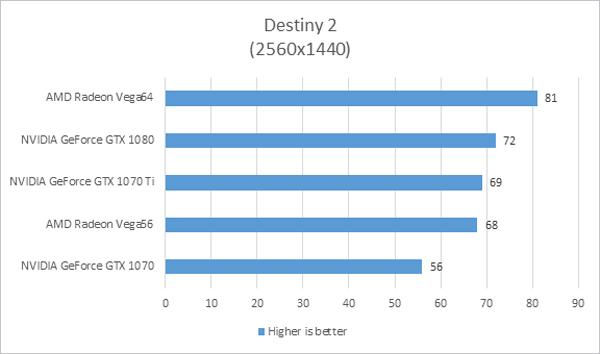
The first game we ran on all the cards was Bungie’s new online shooter Destiny 2 which has you shooting up the galaxy in the name of intergalactic peace or some such nonsense.
Destiny 2 appears to be very well be very well optimised, running at a very high frame rate on all the graphics cards we tested. As such, with an average frame of 121fps the 1070 Ti is arguably overkill for playing this game on a 1920x1080 monitor. Even when we upped the resolution to 2560x1440 all the cards performed well, although the standard 1070 was beginning to struggle with the game occasionally feeling a little sluggish. The 1070 Ti on the other hand was much faster, speeding along at 69fps, barely any slower than the significantly more expensive 1080. Interestingly the Vega64 took pole position in Destiny 2 at 2560x1440, although it’s so much more expensive than the other cards it’s hard to justify the price.
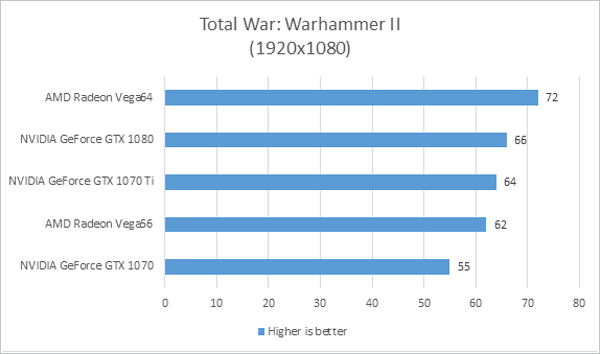
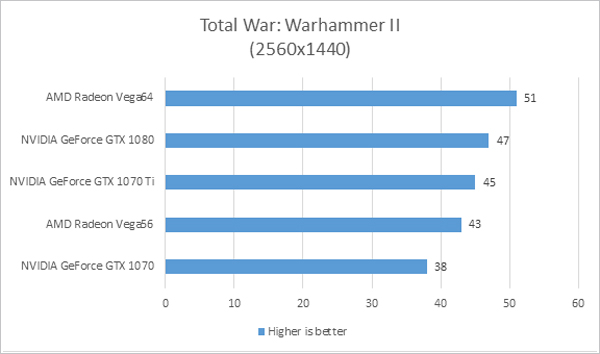
We also ran the latest Warhammer II edition of the incredibly popular RTS franchise Total War on all the cards. This latest instalment adds in Lizardmen, High Elves, Dark Elves and Skaven as playable armies for the first time.
Just like in Destiny 2 the 1070 Ti turned in very similar performance to the 1080 in Warhammer II with only 2fps separating the two cards, far too small a difference to actually be visible by the human eye. Given the attractive pricing of the 1070 Ti this makes the new card a real bargain if you’re keen on Warhammer II.
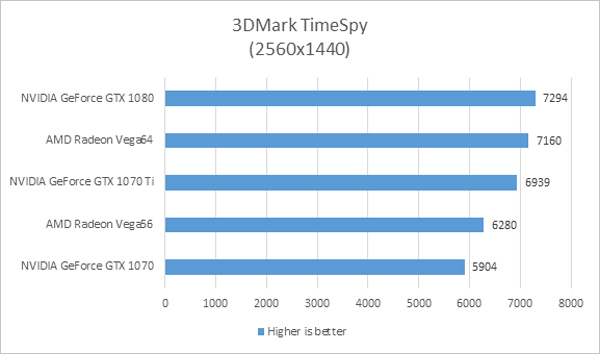
TimeSpy is a popular synthetic benchmark by FutureMark and measures the ability of a PC to render several different 3D scenes at 2560x1440. As we saw in the real games the 1070 Ti performs much closer to the 1080 than the 1070, achieving a very fast score of 6939 points. This is a fair bit faster than the Vega56 which lagged behind with 6280 points.
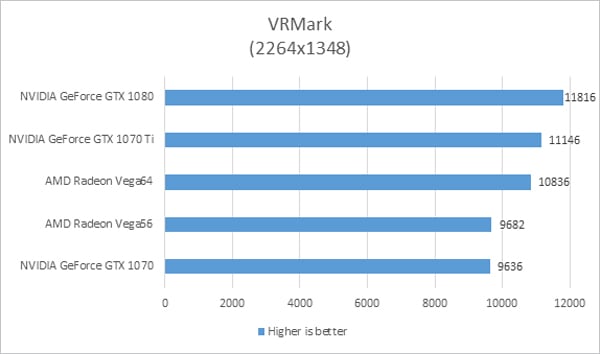
All five of the graphics cards are VR Ready so we also ran the VRMark test by FutureMark to see how fast they really are for VR Gaming. Once again the 1070 Ti proved a real champ, with the second highest score, speeding past the much more expensive Vega64 card, showing that if VR is your thing an NVIDIA card is the way to go.
Conclusion
At £439 the new GeForce GTX 1070 Ti neatly fills the space in the NVIDIA line-up between the £375 GTX 1070 and £489 GTX 1080 cards. For the last couple of months that gap was being exploited by the AMD Radeon Vega56, but now the GTX 1070 Ti is here also.
In both games we tested, Destiny 2 and Total War: Warhammer II the GTX 1070 Ti proved faster than the Vega56 while the same was also true in the synthetic benchmarks TimeSpy and VRMark.
What’s more, even the basic blower edition GTX 1070 Ti’s are considerably quieter than the Vega56, which makes a loud whooshing noise when gaming. Given that both cards currently retail for a similar price the GTX 1070 Ti is clearly the better card.
In fact, the GTX 1070 Ti offers such good performance that it makes the ageing GTX 1080 look a little bit worse for wear. This is because averaged across all six benchmarks the GTX 1070 Ti was only 4% slower than the GTX 1080, which is arguably too small a difference for humans to notice. On the other hand the GTX 1080 is on average a significant £50 more expensive than the GTX 1070 Ti, making the new card the one to buy.
This is even more apparent when you overclock the GTX 1070 Ti. We tested a variety of cards from partners such as EVGA and Asus, and easily overclocked the GPU from its base clock of 1607MHz to over well over 1750MHz and the VRAM from 8000MHz to 8350MHz, boosting the card’s performance by around 6%, making it faster than a GTX 1080. Of course, GTX 1080s can also be overclocked; the point is that the new GTX 1070 Ti can produce GTX 1080 performance at a much more affordable price, making it the new go-to graphics card this winter.
Visit scan.co.uk to browse an extensive range of GeForce GTX 1070 Ti graphics cards, plus all the other mentioned in this Tekspek. We also offer a huge range of pre-built and configurable 3XS Systems featuring the new GTX 1070 Ti.

3. WD unveils monster hard disks
With SSDs grabbing all the headlines thanks to their superlative performance, it shouldn’t be forgotten that despite being 60 years old this year, there is still room to improve the hard disk.
The main field of development is increasing data density, which in turn will allow significantly higher capacity drives in the same form factor. For the last decade the next big thing in hard disks was supposed to be HAMR (Heat Assisted Magnetic Recording), which uses a laser to heat up the platter before the head writes data, enabling a smaller head to be used, which in turn leads to increase data density. However, as of late 2017 there still aren’t any HAMR drives in mass production.
As a result WD just announced that it still believes HAMR drives are a long way off so instead will be focussing its R&D on drives using an alternative technology call MAMR (Microwave Assisted Magnetic Recording). Instead of heating the platter, MAMR heads generate a microwave field from a STO (Spin Torque Oscillator) to flip the magnetic polarity of individual grains on the platter more quickly than a traditional head.
While the concept of MAMR isn’t new, what is news worthy is that WD is now predicting that it will be ready to start mass production of MAMR hard disks as soon as 2019, with projected capacities of 40GB by 2015.

4. Acer Windows Mixed Reality Headset
After multiple false starts 2017 was the year in which VR really arrived, with the leading headsets from Oculus and HTC providing a compelling, albeit slightly fuzzy, experience. A bit part of the reason for that success was not just the hardware, but also the software, with the Oculus Store and Steam providing access to thousands of VR games, experiences and films via their online marketplaces.
Acer is now set to join that club, with AH101 headset.
Despite the ‘Mixed Reality’ nomenclature, the two cameras on the front are motion detection and cannot be used to create a true augmented reality experience. That said, this does mean you don’t need to fuss about with external sensors like with the Oculus Rift and HTC Vive.
Spec wise the Acer AH101 does everything you’d expect with a 1440 x 1440 display for each eye, which is slightly higher than the Oculus Rift and HTC Vive although the field of view of 105 degrees is slightly narrower than the market leaders. You also need to buy a separate headset for the Acer as it doesn’t have built in speakers.
The Acer AH101 mixed reality headset is the third big-brand VR headset to launch in the UK and so should be applauded. However, whether you’re planning to use VR for work or play it is important to note the limitations of all current VR headsets. Still, it’s great to see another potential choice in the market.

5. Scan wins Best Online Retailer
We’re delighted to share the news that Scan won the award for Best Online Retailer at the PC Pro Technology Awards 2017. This award is voted for by the readers of PC Pro, and in the words of the judges ‘The online retailer category is the most hotly contested of them all, so well done to Scan for fending off stern challenges from big names such as Amazon and John Lewis. The Bolton-based company performed particularly well in the holy trinity: customer support if things went wrong, speed of delivery and tracking information. ‘I just think Scan has that little je ne sais quoi about it that’s hard to explain,” wrote James Winnard, ‘but you know it puts them ahead of the competition. 10/10.”

"Benchmark-breaking speed & stunning design"
Is how Custom PC described 3XS’s high-end Core X gaming PC, the Carbon Fluid Extreme SLI. The review continues with ‘Scan’s 3XS Carbon Fluid Extreme SLI is designed around a stunning monochrome theme. It looks amazing, operates quietly, makes light work of multi-threaded work and scythes through any gaming task, plus you get a fast SSD and a fantastic custom water-cooling loop. This machine will blitz through 4K gaming, while also having enough power to deal VR headsets and complex multi-monitor rigs.
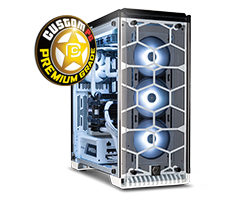
"The build is world-class"
Hardware Heaven also the Carbon Fluid Extreme SLI gaming PC and had this to say ‘The Carbon Fluid Extreme is a stunning-looking machine, and building a system that looks like this obviously takes plenty of time and also involves spending extra cash on cooling gear. It’s one of the best-looking systems we’ve ever seen. It’s a large, stunning case, with honeycomb plastic and dust filters across all of its panels, tempered glass everywhere and thumbscrews that can be easily used to remove any of the panels. It’s rock-solid, too. There’s loads of hardware inside this system, and Scan has done a stellar job with putting it all together. The two graphics cards delivered incredible performance, but that’s hardly a surprise. That incredible pace translated to jaw-dropping speed in our games tests. This is a stunning bit of kit. The water-cooling looks fantastic, and the rest of the build is world-class.
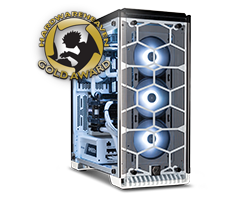
"This is almost exactly how we'd imagine a well-rounded Core i7-8700K base unit to be"
3XS Systems has also been busy designing new Coffee Lake PCs, the first to be reviewed was on HEXUS, which described the Vengeance Ti as ‘almost exactly how we'd imagine a well-rounded Core i7-8700K base unit to be. There's no doubt about it, Core i7-8700K ticks a lot of the right boxes. Single-thread performance remains best in class, and improved multi-threaded capabilities bridge the gap between previous-generation parts and premium X299. Operating at 5GHz across all cores is merely the icing on the Core i7 cake. The 3XS Z370 Vengeance Ti does an admirable job of keeping noise levels down to a minimum when the CPU is placed under full load. Cranked-up to 5GHz across all cores and armed with an overclocked GeForce GTX 1080 Ti graphics to boot, this well-built system represents all-round performance excellence at a cost of £2,300.

"Scan's build is smart, balanced, and without any unnecessary hardware fluff"
PC Games N also took a look at one of our other Coffee Lake launch PCs, the Gamer 1080, and wrote that ‘Everything in the 3XS Gamer is there to make it a great gaming rig, which it is. Scan have introduced a 3XS Gamer system with a high-end spec, but zero extraneous fat. Everything they’ve chosen to fill it out with is there to make good with the gaming, without unnecessarily adding to the cost’.
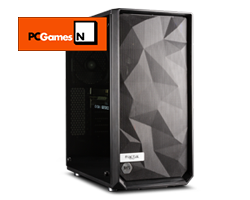
"A versatile and well-balanced triumph."
Another one of our Coffee Lake launch PCs, the Vengeance Aura SLI was also reviewed by Custom PC, which wrote that ‘Scan’s Coffee Lake debut is a stunning system in every area’ and that ‘The vast processing power is paired with the ample graphics speed, easily playing all our test games at 4K and churning out amazing frame rates at 2,560 x 1,440.’

"A phenomenally fast workstation for both CAD and design viz"
We’ve also developed a new high-end graphics workstation, the WI6000 Viz, which features an overclocked 18-core Core i9 processor. Develop3D took a look, writing that ‘The company’s brand new Scan 3XS WI6000 Viz workstation is designed to offer the best of both worlds – high clock speed, combined with high core count. And from what we have seen, you really can now have your cake and eat it too. The result is like nothing we have seen before — a workstation that offers incredible performance for both single-threaded CAD and multi-threaded ray trace rendering operations. There really is little compromise. But this doesn’t mean it’s louder. In fact, the machine is remarkably quiet in operation, even under heavy loads. To say we were impressed with the performance of Scan’s new viz-focused workstation would be a bit of an understatement.
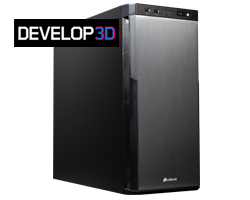
"PC Pro Workstation of the Year – 2017"
Finally, we’re also delighted to announce that the WI6000 Viz was also voted Best Graphics Workstation of the year for 2017 by PC Pro magazine.
